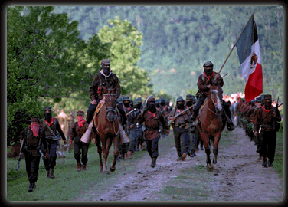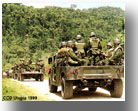
|
|
|
|
|
|
|
|
|
|
Roles of the People in the Zapatista Movement
The men and women of Chiapas involved in the Zapatista social movement
have different roles that contribute very significantly to its successful
progress. They must work together to make dynamic changes for their
families and communities. Men are divided into two general groups,
those who leave home to fight or work with councils and those who remain
behind to take on the extra work the former left behind. Men make
up the majority of rebel soldiers and of the community councils.
The community councils work to make decisions that will guide future plans
for soldiers and communities. It is indigenous men that appear to
make up the majority of Zapatista councils devising activities designed
to win greater autonomy. The Zapatistas have made it clear that:
“We wish to enjoy the full freedom to continue being who we are.
We wish to create conditions that will make this possible (Gossen 1996).
But while there are so many men working toward this end, there must be
others who are also willing to sacrifice their time to contribute to the
welfare of the families whose men have left to become soldiers. They
spend more time in the fields and doing all sorts of work to keep local
domestic life running smoothly. There is a social movement at work,
but the people must also eat.
 Women have
carved a non-traditional role within the Zapatista movement. They
too are leaving their homes to become rebel soldiers. The new role
women have taken is a symbol of the changes in Chiapas and the progress
of democratic movements. They are adamant in their quest for personal
and communal autonomy and fiercely defend their children's rights for a
better future. Women who become soldiers sacrifice marriage and family
and like men leave their homes behind and take on the grueling life of
a ‘rebel.’ There are also many families whose women remain at home
keeping up with child-care responsibilities. While some work toward
the emancipation of women, others remain in a traditional role of wife
and mother. These women take on lots of extra responsibility to their
community as well as extra work within that community. There are
many that have become widows in the course of Zapatista progress, and they
especially need the help of communal efforts.
Women have
carved a non-traditional role within the Zapatista movement. They
too are leaving their homes to become rebel soldiers. The new role
women have taken is a symbol of the changes in Chiapas and the progress
of democratic movements. They are adamant in their quest for personal
and communal autonomy and fiercely defend their children's rights for a
better future. Women who become soldiers sacrifice marriage and family
and like men leave their homes behind and take on the grueling life of
a ‘rebel.’ There are also many families whose women remain at home
keeping up with child-care responsibilities. While some work toward
the emancipation of women, others remain in a traditional role of wife
and mother. These women take on lots of extra responsibility to their
community as well as extra work within that community. There are
many that have become widows in the course of Zapatista progress, and they
especially need the help of communal efforts.
As soldiers of the Mexican state continually attempt to establish
a presence in Chiapas, it is most often the women who are successful in
turning their trucks away.
 “We’re
tired of running away from the soldiers,’ says Irma Morales Perez, ‘When
they came in 1995, we abandoned the community and hid in the mountains
for a month. We were cold and hungry—we had no food and no way to get food.
We spent two years trying to recover from the crops we lost then.
We don’t want that again, so we organized and decided to push the soldiers
out and stay here with our work.’ ‘Every day the women get madder.
And the madder they get, the stronger they get.’” (Flinchum 2).
“We’re
tired of running away from the soldiers,’ says Irma Morales Perez, ‘When
they came in 1995, we abandoned the community and hid in the mountains
for a month. We were cold and hungry—we had no food and no way to get food.
We spent two years trying to recover from the crops we lost then.
We don’t want that again, so we organized and decided to push the soldiers
out and stay here with our work.’ ‘Every day the women get madder.
And the madder they get, the stronger they get.’” (Flinchum 2).
Soldiers will not shirk from violence against women. Although
women and children are not as often murdered during protest as men are,
they nonetheless suffer physical attacks.
“Aguilera Sanchez pulls the baby forward and opens up the shawl, showing a purple bruise on the child’s lower back. “I said he was a filthy government whore and I picked up a stick and defended myself. My friend Juana, they hit her so hard on the head that blood came out and she fell on her baby. But what can you do? Here we are” (Flinchum 2).
The women of Chiapas must endure great tribulations in order to protect
their community and their children’s safety. Many women show no fear
but face such great obstacles it is difficult to imagine how hard it must
be to fight fear in order that they may fight injustice.
The men and women of Chiapas have formed several types of organizations
to further their cause. These often begin locally and branch out
to work with similar organizations in surrounding communities. The
organizations include political parties, councils, cooperatives, unions,
and teams for community projects. Regardless of their primary role
within the Zapatista movement, the signature aspect is communal involvement.
The people of Chiapas who are involved in this struggle are always working
together. They have made it clear that anyone who wants to get involved
and fight for change will not be fighting alone.
The working class men and women of Chiapas are the leaders of
the Zapatista social movement, and have equal voice and influence regardless
of gender. They are raising children who are learning new non-traditional
ways of living in the midst of a modern struggle for autonomy and human
rights. Often these children are Zapatistas in training, wanting
to become soldiers like their fathers, brothers, mothers, or sisters.
They are also in a unique position to observe the cooperation of many different
ethnic groups in a struggle for greater indigenous rights. There
are Tzeltales from Ocosingo, Choles from the north, Tzotzils from the highlands,
Tojolabales from the lowlands, and Zoques from the central valleys of Chiapas.
All of these groups have come together to form a cooperative union and
fight together for the progress of social democracy. They are calling
for big changes, and have reflected their commitment by changing their
own lives radically in order to make changes possible. The children
of Chiapas will continue growing up with this altered way of life.
The Zapatista movement has fundamentally changed their lives and will hopefully
bring even more radical positive social changes in the future.